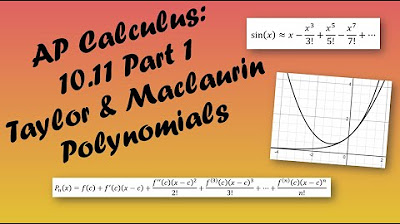Calculus BC – 10.11 Finding Taylor Polynomial Approximations of Functions
TLDRIn this engaging lesson, Mr. Bean introduces Taylor polynomial approximations, explaining their purpose and how they simplify calculus operations. He demonstrates the process of constructing a Taylor polynomial, using the exponential function as an example, and highlights the benefits of higher-order approximations. The lesson also distinguishes between Taylor and Maclaurin polynomials, with a focus on their applications and the formula for calculating coefficients.
Takeaways
- 📚 Taylor polynomial approximations are used to approximate functions, making them easier to work with for calculations like derivatives and integrals.
- 🔍 The process starts by choosing an x value, denoted as 'c', where the approximation will be centered.
- 🌟 The Taylor polynomial must have the same y-value as the original function at x=c.
- 📈 The approximation improves by matching not only the y-value but also the derivatives of the original function at x=c.
- 🧮 The general formula for a Taylor polynomial is given by f(c) + f'(c)(x-c) + f''(c)(x-c)^2/2! + ... + f^n(c)(x-c)^n/n!.
- 🌐 A Maclaurin polynomial is a special case of a Taylor polynomial centered at x=0.
- 🔢 The coefficients of the Taylor polynomial are derived by evaluating the function and its derivatives at the center point 'c'.
- 📊 As the order of the Taylor polynomial increases, the approximation becomes more accurate, especially further away from the center 'c'.
- 📚 Example: The Taylor polynomial approximation of e^x centered at x=0 is 1 + x + x^2/2! + x^3/3! + ... + x^n/n!.
- 🔍 To find the coefficient of a specific term in the Taylor polynomial, focus on the nth derivative evaluated at 'c' and divided by n!.
- 🎓 The Taylor polynomial is a powerful tool in calculus for simplifying complex functions and understanding their behavior.
Q & A
What is the main topic of the lesson?
-The main topic of the lesson is Taylor polynomial approximations and how they are used to approximate functions.
Why are Taylor polynomials useful in calculus?
-Taylor polynomials are useful because they simplify the process of working with functions, especially when it comes to taking derivatives or performing integrations.
What is the first step in creating a Taylor polynomial approximation?
-The first step is to choose an x value, denoted as c, where the approximation will be centered and ensure that the polynomial has the same y value as the original function at x=c.
How does the degree of the Taylor polynomial affect the approximation?
-The degree of the Taylor polynomial determines the accuracy of the approximation. Higher degree polynomials generally provide better approximations, especially further away from the center point c.
What is a Maclaurin polynomial?
-A Maclaurin polynomial is a special type of Taylor polynomial that is centered at x equals zero. It simplifies the Taylor polynomial formula by setting all the c values to zero.
How does the Taylor polynomial formula differ from the Maclaurin polynomial formula?
-The Taylor polynomial formula includes the x value c as a center point, while the Maclaurin polynomial formula assumes that c is always zero, simplifying the expression.
What is the general formula for a Taylor polynomial?
-The general formula for a Taylor polynomial of order n, centered at x=c, is: (f(c) + f'(c)(x-c)/1! + f''(c)(x-c)^2/2! + ... + f^n(c)(x-c)^n/n!).
What is the process for finding the nth coefficient in a Taylor polynomial?
-To find the nth coefficient, you evaluate the nth derivative of the function at the center point c and then divide by n!.
How does the approximation error change as the order of the Taylor polynomial increases?
-As the order of the Taylor polynomial increases, the approximation error typically decreases, leading to a more accurate representation of the original function.
What is the practical application of Taylor polynomials in solving calculus problems?
-Taylor polynomials are used to approximate functions for easier computation of derivatives and integrals, as well as to estimate function values at points where the function may not be explicitly known or is too complex to handle directly.
Outlines
📚 Introduction to Taylor Polynomial Approximations
This paragraph introduces the concept of Taylor polynomial approximations, explaining their purpose in approximating functions, particularly because polynomials are easier to work with for operations like differentiation and integration. The speaker, Mr. Bean, uses a graphical approach to illustrate how a Taylor polynomial is constructed around a chosen x-value (c) and emphasizes the importance of matching the function's value and derivatives at this point for accurate approximations. The example of the exponential function e^x centered at x=0 is used to demonstrate the process of creating a first-order approximation, which is a linear approximation near x=0.
📈 Enhancing Approximations with Higher-Order Polynomials
The speaker continues the discussion on Taylor polynomials by explaining how higher-order approximations can significantly improve the accuracy of the approximation. The paragraph details the process of creating a second-order Taylor polynomial for the exponential function e^x, emphasizing the need to match the function's first and second derivatives at x=0. The speaker then introduces the general formula for Taylor polynomials, highlighting the role of factorials and derivatives in constructing the polynomial. The concept of Maclaurin polynomials as a special case of Taylor polynomials centered at x=0 is also introduced, with the speaker noting the simplification that occurs when c=0.
🔢 Applying Taylor Polynomials to Functions
In this paragraph, the speaker demonstrates the practical application of Taylor polynomials by working through the process of finding the third-degree Maclaurin polynomial for the function f(x) = e^(2x). The speaker outlines the steps of calculating the function's derivatives, evaluating them at x=0, and plugging these values into the Maclaurin polynomial formula. The resulting polynomial is then used to approximate the value of the function at x=0.2, showcasing the effectiveness of higher-order polynomials in closely approximating the actual function.
📊 Evaluating and Simplifying Taylor Polynomials
The final paragraph focuses on evaluating and simplifying Taylor polynomials. The speaker calculates a fourth-order Taylor polynomial for a function centered at x=1 and uses it to approximate the function's value at x=1.1. The speaker emphasizes the closeness of the approximation to the actual function value, highlighting the benefits of higher-order polynomials. The paragraph concludes with a discussion on coefficients of Taylor polynomials, explaining how to find the coefficient of a specific order by evaluating the corresponding derivative at the center point and dividing by the appropriate factorial.
Mindmap
Keywords
💡Taylor Polynomial
💡Maclaurin Polynomial
💡Derivatives
💡Approximation
💡Exponential Function
💡Center Point
💡Polynomial
💡First Order Approximation
💡Second Order Approximation
💡Third Order Approximation
💡Factorial
Highlights
Introduction to Taylor polynomial approximations and their use in approximating functions.
Reasons for using polynomial approximations, such as ease of working with polynomials in differentiation and integration.
The process of creating a Taylor polynomial approximation starts with selecting an x value, denoted as c.
The Taylor polynomial must have the same y-value as the original function at the chosen x value (c).
Expansion of the approximation around the chosen x value (c), either to the left or right.
The concept of a first-order Taylor polynomial approximation, which is linear and suitable for small intervals around c.
The derivation of a second-order Taylor polynomial for the exponential function e^x centered at c=0.
The general formula for a Taylor polynomial, including the factorial terms and their significance.
Maclaurin polynomials as a special case of Taylor polynomials centered at x=0.
An example of finding the third-degree Maclaurin polynomial for f(x)=e^(2x) and its approximation at x=0.2.
The process of evaluating the Taylor polynomial at a specific point, demonstrating its approximation capability.
The construction of a fourth-order Taylor polynomial for a function centered at x=1 and its approximation at x=1.1.
The importance of higher-order polynomials for better approximations and the trend of increasing accuracy with each additional degree.
The method for finding the coefficient of a specific term in a Taylor polynomial.
An example calculation of the coefficient for the fourth-degree term in a Taylor polynomial.
The conclusion that Taylor and Maclaurin polynomials are powerful tools for approximating functions and their practical applications.
Transcripts
5.0 / 5 (0 votes)
Thanks for rating:





